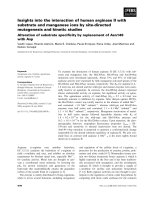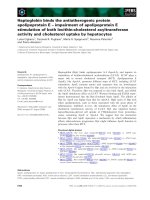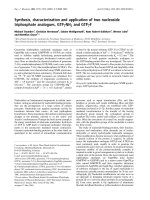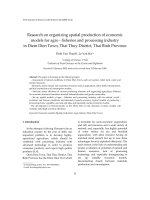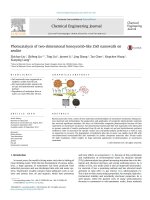Production of two dimensional layeredmaterials graphite oxide and grapheneby plasma electrochemistry and mos2 nanosheets by quenching method
Bạn đang xem bản rút gọn của tài liệu. Xem và tải ngay bản đầy đủ của tài liệu tại đây (13.07 MB, 117 trang )
國立交通大學
材料科學與工程學系
博士論文
層狀二維材料製備-由電漿電化學製備石墨氧化物、
石墨烯及由焠火製備奈米片狀二硫化鉬
Production of two-dimensional layered materials-graphite
oxide and graphene by plasma electrochemistry and MoS2
nanosheets by quenching method
姓 名:
鄧文成
指導教授 :
韋光華
中華民國 一百零三年四月
國立交通大學
National Chiao Tung University
博士論文
Doctoral Dissertation
層狀二維材料製備-由電漿電化學製備石墨氧化物、
石墨烯及由焠火製備奈米片狀二硫化鉬
Production of two-dimensional layeredmaterials-
graphite oxide and grapheneby plasma electrochemistry
and MoS2 nanosheets by quenching method
系
所 :
Department of Materials Science and Engineering
學
號 :
9818843
姓
名 :
DANG VAN THANH
指導教授 :
Prof. KUNG-HWA WEI
Hsinchu, April 17, 2014
層狀二維材料製備-由電漿電化學製備石墨氧化物、
石墨烯及由焠火製備奈米片狀二硫化鉬
Production of two-dimensional layered materials-graphite
oxide and graphene by plasma electrochemistry and MoS2
nanosheets by quenching method
研究生: Dang Van Thanh
Student: Dang Van Thanh
指導教授: 韋光華
Advisor: Prof. Kung-Hwa Wei
國立交通大學
材料科學與工程學系
博士論文
A thesis
Submitted to Department of Materials Science and Engineering
College of Engineering
National Chiao Tung University
in partial Fulfillment of Requirements
for the Degree of Doctor of Philosophy
in
Materials Science and Engineering
April 2014
Hsinchu, Taiwan, Republic of China
中華民國 一百零三年四月
Abbreviations
HOPG: highly ordered pyrolytic graphite
GE: recycled graphite
HG: high purity graphite
CP: cathodic plasma process
VPE: vapor plasma envelope
EG: expandable graphite
PEGO: plasma-expanded graphite oxide
PEEG: Plasma electrochemically exfoliated graphene
DI: deionized water
EPEGO: exfoliated PEGO
NMP: N-methyl-2-pyrrolidone
MB: Methylene Blue
GSs: Graphene sheets
MoS2-DI: Exfoliation of solution of MoS2 in DI water, without quenching.
MoS2-DIQ: Exfoliation of solution of MoS2 in DI water, with quenching.
MoS2-KOH: Exfoliation of solution of MoS2 in aqueous KOH, without quenching.
MoS2-KOHQ: Exfoliation of solution of MoS2 in aqueous KOH, with quenching.
Table of Contents
Abstract ................................................................................................................. III
Acknowledgment .................................................................................................. VI
Figure List ............................................................................................................ VII
Table List .............................................................................................................. XI
Chapter 1: Introduction ....................................................................................... 1
Chapter 2: Overview of electrochemical exfoliation and plasma electrolysis 4
2-1 Introduction to graphene................................................................................... 4
2-2 Electrochemical approaches to produce graphene ........................................... 5
2-3 Cathodic plasma electrolysis (CPE) to produce nano-materials .................... 10
2-4. Solution-based exfoliation approach to produce MoS2 ................................. 12
Chapter 3: Plasma electrolysis allows the facile and efficient production of
graphite oxide from recycled graphite .............................................................. 14
3.1 Introduction ..................................................................................................... 14
3.2 Experimental ................................................................................................... 17
3.2.1 Preparation of PEGO and PEHGO ........................................................... 17
3.2.2 Preparation of EPEGO ................................................................................. 20
3.2.3 Adsorption of MB on PEGO ....................................................................... 20
3.2.4 Measurements and Characterization ............................................................ 21
3-3. Results and discussions ................................................................................. 21
3-4 Conclusions .................................................................................................... 35
Chapter 4: Plasma-assisted electrochemical exfoliation of graphite for rapid
production of graphene sheets ........................................................................... 37
4-1 Introduction .................................................................................................... 37
4-2 Experimental ................................................................................................... 38
4-2.1Preparation of plasma- electrochemically exfoliated graphene (PEEG) ..... 40
4-2.2 Preparation of PEEG dispersion .................................................................. 40
i
4.2.3 Measurements and Characterization ............................................................ 40
4-3 Results and discussions .................................................................................. 41
4-4 Conclusions .................................................................................................... 53
Chapter 5: The influence of electrolytic concentration on morphological and
structural properties of plasma-electrochemically exfoliated graphene ....... 54
5-1 Introduction .................................................................................................... 54
5-2 Experimental ................................................................................................. 55
5.2.1 Preparation of plasma- electrochemically exfoliated graphene (PEEG) ..... 56
5-2-2 Preparation of PEEG dispersion ................................................................. 56
5.2.2 Measurements and Characterization ............................................................ 56
5-3 Results and discussions .................................................................................. 57
5-4 Conclusions .................................................................................................... 64
Chapter 6: Production of few-layer MoS2 nanosheets through exfoliation of
liquid N2–quenched bulk MoS2 ..................................................................................................................65
6-1 Introduction .................................................................................................... 65
6-2 Experimental ................................................................................................. 67
6.2.1 Preparation of exfoliated MoS2 nanosheets ................................................. 67
6-2-2 Preparation of MoS2 dispersion .................................................................. 67
6.2.3 Measurements and Characterization ............................................................ 68
6-3 Results and discussions
...................................................... 68
6-4 Conclusions .................................................................................................... 79
Chapter 7: Conclusion and outlook for future ................................................ 80
References ............................................................................................................ 84
List of Publication ............................................................................................. 102
ii
Abstract
The purpose of this work is to find out new approaches for one-pot synthesis
of graphite oxide and graphene by plasma electrochemical exfoliation of graphite
in a basic electrolyte solution in a short-reaction time with regards of
environmental friendliness, energy/time saving, and low cost. First of all, we
adopted a highly efficient cathodic plasma (CP) process in which the vapor plasma
envelope calorific effect provides instant oxidation and expansion of graphite for
producing plasma-expanded graphite oxides (PEGOs) from recycled graphite
electrodes (GEs) or high purity graphite (HG), within a reaction time of 10 min
without the need for strong oxidants or concentrated acids. X-ray diffraction, X-ray
photoelectron spectroscopy and Raman spectroscopy confirmed the dramatic
structural change from GEs or HG to graphite oxides after the CP process.
Furthermore, scanning electron microscopy and transmission electron microscopy
revealed that the graphite oxide possessed a spheroidal morphology, with
dimensions of 1–3 µm, as a result of melting and subsequent quenching during the
plasma electrolysis process. We obtained a stable, homogeneous dispersion of
PEGOs in N-methyl-2-pyrrolidone after sonication and filtering of the centrifuged
PEGOs. We used these spheroidal graphite oxide particles as effective adsorbents
for the removal of pollutants (e.g., Methylene Blue) from aqueous solutions. These
PEGOs also served as good precursors for the preparation of graphite nanopletets.
iii
Sequently, we have demonstrated a new and highly efficient plasma-assisted
electrochemical exfoliation method, involving a plasma-generated graphite cathode
and a graphite anode, for the production of graphene sheets from electrodes in a
basic electrolyte solution in a short reaction time. The AFM images revealed a
lateral dimension of approximately 0.5–2.5 µm and a thickness of approximately
2.5 nm, corresponding to approximately seven layers of graphene, based on an
interlayer spacing of 0.34 nm. Additively, the influence of electrolytic
concentration
on
morphological
and
structural
properties
of
plasma-
electrochemically exfoliated graphene is investigated and presented. Finally, we
developed an efficient solution-based method for the production of few-layer MoS2
nanosheets through exfoliation of bulk MoS2 compounds that were subject to
quenching in liquid N2 and subsequent ultrasonication. AFM images of individual
nanosheets revealed that the thickness varied from 1.5 to 3.5 nm and the lateral
dimensions from 0.5 to 3.5 µm.
iv
摘要:
此實驗的目的是要找出在相對基本的電解液中,能夠快速用電漿電化學剝離法製
造出石墨氧化物及石墨烯並且達到對環境友善、節省能源及時間與低成本的效果。首先,
我們在回收的石墨電極或高純度石墨採用高效率陽極電漿法以蒸汽熱電漿反應對石磨
產生即時氧化及擴張隨後產出展開電漿石墨氧化物,而此法可在不需要強氧化劑或高濃
酸的條件下,十分鐘的反應時間內完成。X-RAY 繞射分析、X-RAY 光電子圖譜或拉曼
圖譜可檢測出在經過陽極電漿法後,從石墨電極或高純度石墨到石磨氧化物的劇烈結構
改變。此外,掃描式電子顯微鏡與穿透式電子顯微鏡更可顯示出石墨氧化物擁有類似圓
球狀的型態,範圍尺度在 1-3μm 間,這是在電漿電解法中融化並隨後冷卻的結果。聲裂
法及離心過濾石墨氧化物後,我們得到在 N-甲基吡咯烷酮中有穩定且同質均勻分布的
展開石墨氧化物。應用上可將類圓球狀的石墨氧化物當作強吸收劑用來去除水溶液中的
髒汙(例如:亞甲基藍)。他也是個好的製造石墨奈米小板之前驅物。隨後,我們也說明如
何由石墨陰陽極電漿電解剝離法在短時間內與簡單電解液的條件下產出石墨烯。原子力
顯微鏡影像顯示出,橫向尺度大約 0.5-2.5μm 及厚度約 2.5nm,相當於七層石墨烯(每層
約 0.34nm)的厚度。最後,我們研究電解液的濃度如何影響電漿電化學剝離石墨烯的表
面形態及結構最後我們發展出一個高效率液相製法使用 N2 將塊狀 MoS2 製備成 MoS2
nanosheets,由 AFM 的圖可以看出分開的 MoS2 nanosheets 的厚度由 1.5 nm ~3.5 nm 且
尺寸大小在 0.5µm ~3.5 µm 之間。。
v
Acknowledgment
First and foremost, I gladly acknowledge my debt to Prof.Kung-Hwa Wei.
Without his constant friendship, generous encouragement and concise advice, this
thesis would never have been completed. Additionally, I am grateful to Prof. ChihWei Chu, Prof. Lain-Jong Li, and Prof. Yao-Jane Hsu because they kindly gave me
much comments and suggestions relating to my research direction. I would also
especially like to recognize Prof. Chih-Wei Chu for permitting me to use his
facilities and equipment.
I would also like to thank Dr. Jian-Ming Jiang, Mr. Hsiu-Cheng Chen, and
Mr. Chien-Chung Pan. They kindly taught me all of equipment in my lab and
helped order facilities, and chemicals equipment for my research setup. Four years
ago, when I started Ph.D. program, my life in the Taiwan was complicated
by language and cultural differences. Many people have helped me in the course
of my research, and any merit on its behalf is in large measure due to them.
Finally, special thanks go to my parents, my wife, and my son. Your love
always made it possible for me to go through tough trails. Thank you for being
there, smiling at me with love, good days or bad days
Dang Van Thanh
Hsinchu, Taiwan
March 2014
vi
Figure List
Chapter 1: Introduction .......................................................................................... 1
Chapter 2: Overview of electrochemical exfoliation and plasma electrolysis ... 4
Figure 2-1. Schematic illustration of the main graphene production techniques. (a)
Micromechanical cleavage. (b) Anodic bonding. (c) Photoexfoliation. (d) Liquid
phase exfoliation.(e) Growth on SiC. Gold and grey spheres represent Si and C
atoms, respectively. At elevated T, Si atoms evaporate (arrows), leaving a carbonrich surface that forms graphene sheets. (f) Segregation/precipitation from carbon
containing metal substrate. (g) Chemical vapor deposition. (h) Molecular Beam
epitaxy. (i) Chemical synthesis using benzene as building block. ............................ 5
Figure 2-2. Timeline for the development of GN using electrochemical technique.
.................................................................................................................................... 7
Figure 2-3. Schematic of the apparatus for synthesis of GN via electrolytic
exfoliation . ................................................................................................................ 9
Figure 2-4. Electrochemical approaches (a) oxidation, intercalation and exfoliation
(negative ions are shown in red colour) and (b) reduction, intercalation and
exfoliation to produce single and multilayer GN flakes. ......................................... 10
Figure 2-5. Typical classification of plasma electrolysis and its applications. ...... 11
Chapter 3: Plasma electrolysis allows the facile and efficient production of
graphite oxide from recycled graphite................................................................. 14
Figure 3-1. Schematic representation of the equipment used for the CP process
combined with ultrasonic vibration. ........................................................................ 19
Figure 3-2. (a) X-ray diffraction patterns of the GE, PEGO, and EPEGO samples,
(b)X-ray photoelectron spectroscopy of C1s signal of PEGO, (c) XRD patterns of
the HGO, HPEGO samples, and (d) X-ray photoelectron spectroscopy of C1s
signal of HPEGO. .................................................................................................... 22
vii
Figure 3-3. SEM images of the (a) GE, (b) PEGO, and (c) EPEGO samples; insets: highmagnification images. ........................................................................................................25
Figure 3-4. (a) Mechanism of formation of PEGO and digital image of VPE. ................27
(b) Mechanism of plasma-mediated expansion of GE. ......................................................27
Figure 3-5. TEM images of (a) GE, (b) HG, (c) PEGO, and (d) HPEGO; ......................29
insets: corresponding SAED pattern. .................................................................................29
Figure 3-6. (a) AFM image of a nanoplatelet of EPEGO deposited on a Si/SiO2 substrate.
(b) Line scan height profile of the sample in (a). (c) HRTEM image of an EPEGO
nanoplatelet; inset: corresponding SAED pattern. ............................................................. 30
Figure 3-7. Raman spectra of the GE, PEGO, and EPEGO samples. ............................... 31
Figure 3-8. Photograph of (a) the dispersion of PEGO in the electrolytic solution, (b) the
sample obtained after filtering the sample in (a) through PVDF (pore size: 0.2 µm) and
re-dispersion in NMP, (c) the sample obtained after ultrasonication of the sample in (b),
and (d) the centrifuged dispersion of PEGO in NMP. .......................................................33
Figure 3-9. UV–Vis spectra of MB solutions in the (red) presence and (black) absence of
PEGO; inset: photograph of the (left) original MB solution and (right) MB-adsorbed
PEGO solution. ..................................................................................................................34
Chapter 4: Plasma-assisted electrochemical exfoliation of graphite for rapid
production of graphene sheets. .......................................................................................37
Figure 4-1. (a) Schematic representation of the equipment used for PEEG. (b–e)
Photographs of (b, c) the electrolytic solution (b) before and (c) after plasma-assisted
electrochemical exfoliation process; (d) the PEEG-based graphene film prepared through
vacuum filtering of the electrolyte after plasma-assisted electrochemical exfoliation
process; and (e) a dispersion of PEEG in an NMP solution. .............................................41
Figure 4-2. (a) XRD patterns and (b) Raman spectra of HG and PEEG and (c, d) XPS
spectra (C 1s signal) of (c) HG and (d) PEEG. ..................................................................42
viii
Figure 4-3. (a, c) SEM and (b, d) TEM images of (a, b) HG and (c, d) PEEG. ..... 45
Figure. 4-4. (a) SEM images of flattened or scrolled PEEG (b, c, d) highmagnification images; Two arrows pointing in opposite directions indicate the
thickness of PEEG that was on the surface of the Si/SiO2 substrate. ...................... 46
Figure. 4-5. TEM images of flattened or scrolled PEEG, inset: corresponding
SAED pattern. Two arrows pointing in opposite directions indicate the thickness of
PEEG that was on the top of the copper grid........................................................... 47
Figure 4-6. AFM images and height profile of a PEEG sample deposited on a
Si/SiO2 substrate. ..................................................................................................... 48
Figure 4-7. (a) SEM high-magnification and (b) TEM images of electrochemically
exfoliated graphene sheets (EEG), (c) Raman spectra of EEG, and (d) AFM image
and height profile of a EEG sample deposited on a Si/SiO2 substrate. ................... 49
Figure 4-8. Proposed mechanisms for the formation of PEEG. ............................. 51
Chapter 5: The influence of electrolytic concentration on morphological and
structural properties of plasma-electrochemically exfoliated graphene. ......... 52
Figure 5-1. Raman spectra of HG and PEEG at various concentrations ................ 57
Figure 5-2. SEM images of the (a) PEEG5, (b) PEEG 10, (c) PEEG 15, and (d)
PEEG 20................................................................................................................... 59
Fig. 5-3. TEM images of the (a) PEEG5, (b) PEEG 10, (c) PEEG 15, and (d)
PEEG 20................................................................................................................... 60
Figure 5-4. AFM images of the (a) PEEG5, (b) PEEG 10, (c) PEEG 15, and (d)
PEEG 20................................................................................................................... 61
Figure 5-5. XPS spectra C 1s signal of (a) HG, (b) PEEG5, (c) PEEG 10, (d)
PEEG 15, and (e) PEEG 20 ..................................................................................... 62
ix
Chapter 6: Production of few-layer MoS2 nanosheets through exfoliation of
liquid N2–quenched bulk MoS2 ......................................................................................................................68
Figure 6-1. Raman spectra of bulk MoS2 and exfoliated MoS2 nanosheets
processed using the liquid N2–exfoliation process .................................................. 72
Figure 6-2. AFM image and height profile of MoS2 samples processed from a
dispersion of exfoliated MoS2.................................................................................. 73
Figure 6-3. TEM image of a MoS2 sample processed from a dispersion of
exfoliated MoS2; inset: SAED pattern and EDS spectrum of the in situ–recorded
area. The Cu signal arose from the TEM support grid ............................................ 74
Figure 6-4. Suggested mechanism for the formation of exfoliated MoS2 through
quenching and exfoliation processes. ...................................................................... 75
Figure 6-5. Raman spectra of raw MoS2 (bulk MoS2) and exfoliated MoS2 samples
processed from solutions of MoS2 in DI water and aqueous KOH. ........................ 78
Figure 6-6a. AFM images and height profiles of MoS2-DI.................................... 79
Figure 6- 6b. AFM images and height profiles of MoS2-KOH. ........................... 80
Figure 6-6c. AFM images and height profiles of MoS2-DIQ. ............................... 81
Figure 6-6d. AFM images and height profiles of MoS2-KOHQ. ........................... 82
x
Table List
Chapter 3: Plasma electrolysis allows the facile and efficient production of
graphite oxide from recycled graphite................................................................. 14
Table 3-1. The relative atomic percentage of various functional groups in PEGO
and HPEGO estimated based on the area under the C 1s peaks.............................. 24
Chapter 4: Plasma-assisted electrochemical exfoliation of graphite for rapid
production of graphene sheets. ............................................................................. 37
Table 4-1. Relative atomic percentages of carbon atoms in various functional
groups in HG and PEEG, estimated based on the areas under the C 1s peaks........ 44
Table 4-2. Comparison between graphene sheets produced with plasma-assisted
and conventional electrochemical exfoliation methods. ......................................... 50
Chapter 5: The influence of electrolytic concentration on morphological and
structural properties of plasma-electrochemically exfoliated graphene. ......... 54
Chapter 6: Production of few-layer MoS2 nanosheets through exfoliation of
liquid N2–quenched bulk MoS2 ............................................................................. 65
Table 6-1. Exfoliation of solutions with and without quenching treatment ........... 72
xi
Chapter 1: Introduction
Graphene (GNs), a single layer of carbon atoms bound together in a
hexagonal lattice (i.e., a two-dimensional form of graphite),1 has many potential
applications in, for example, energy-storage materials,2-6 polymer composites,7-9
transparent conductive electrodes,10-13 memory devices,14-16 and sensors.17-20 To
meet the demand, large-scale production of graphene is required. Several methods
have been developed for the preparation of GNs, such as: electrochemical
exfoliation,21,22 arc discharging,23,24 mechanical milling
based exfoliation
8,27-30
25,26
, expanded graphite-
and chemical reduction of exfoliated graphite oxide
(GO).31-34 Among these methods, chemical oxidation of graphite, conversion of the
resulting graphite oxide to graphene oxide, and the subsequent reduction of
graphene oxide is widely considered as one of most commonly approach for the
large-scale production of GNs. Unfortunately, the mixtures of strong oxidants and
concentrated acids, which is used to prepare GOs, are highly toxic and dangerously
unstable, so extra safety precautions are required.35,36 In addition, the GO
production via oxidation of graphite usually consumes long time. Therefore, an
alternative approach for producing GO or graphene from available graphite-based
sources with simple, low cost equipments and rapid throughput processing are
highly desirable. The key for such a process is the exfoliation of graphite via fast
and controlled electrochemical exfoliation of graphite. In fact, electrochemical
exfoliation of graphite has been reported to be a green and cost-effective approach
for producing graphite oxides and high-quality few-layer graphene flakes in high
yield using simple equipment. Cui et al.37 reported the preparation of graphite
oxide nanoparticles and graphene by electrochemical oxidation of graphite anode
in deionized water at galvanostatic mode. These facts suggest that it is possible to
1
disaggregate graphite into graphite oxide or individual graphene sheets using
controlled electrochemical exfoliation approach.
In this dissertation, a new and highly efficient plasma electrochemical
exfoliation method will be described consisting of a plasma-generated graphite
cathode and a stainless steel anode or graphite anode for the production of graphite
oxide or graphene sheets. The purpose of this work is to find out new approaches
for one-pot synthesis of graphite oxide and graphene by the plasma
electrochemical exfoliation of graphite in a basic electrolyte solution in a shortreaction time with regards of environmental friendliness, energy/time saving, and
low cost. In addition, we also demonstrate a new and simple solution-based
method for the production of few-layer MoS2 nanosheets through exfoliation of
bulk MoS2 compounds through quenching in liquid N2.
After the introduction, a brief overview of methods for preparation of
graphene, particularly the electrochemical method and plasma electrolysis
processing, is presented in chapter 2. Chapter 3 describes our proposed method to
synthesize graphite oxide using plasma electrolysis. The oxidized mechanism of
graphite into graphite oxide will be discussed. The as-synthesized graphite oxide
produced through this process is demonstrated as an effective adsorbent for a
removal of Methylene Blue from aqueous solutions and can serve as a suitable
precursor for the preparation of graphite nanoplatelets. Chapter 4 contains a highly
efficient and green method for the production of graphene sheets from both
graphite electrodes in a basic electrolyte solution through an electrochemical
process involving a plasma-generated graphite cathode. The influence of
electrolytic concentration on morphological and structural properties of plasmaelectrochemically exfoliated graphene is investigated and presented in chapter 5.
Chapter 6 develops and applies further the exfoliated mechanism in chapter 3-4 for
2
the production of few-layer MoS2 nanosheets through exfoliation of bulk MoS2
compounds through quenching in liquid N2.
Finally, the features of this
dissertation and outlook for further studies will be discussed in chapter 7.
3
Chapter 2: Overview of electrochemical exfoliation and plasma electrolysis
2-1. Introduction to graphene
Graphene (GNs), a single layer of carbon atoms bonded together in a
hexagonal lattice or two-dimensional graphite, has recently emerged as a rising star
in materials science. The excellent properties of graphene were reported by high
values of its Young’s modulus (~ 1100 GPa), fracture strength (125 GPa) [1], 1
thermal conductivity (~ 5000 W m-1 K-1),2 mobility of charge carriers (200 000 cm2
V-1 s-1) [3]3 and specific surface area (2630 m2 g-1) [4].3,4 Several methods have
been developed for preparing graphene sheet since it was firstly isolated by
Novoselov and Geim using Scotch tape in 2004, such as: electrochemical
exfoliation,5,6 arc discharging,7,8 mechanical milling
exfoliation
11-15
9,10
, expanded graphite-based
and chemical reduction of exfoliated graphite oxide.16-19. A
summary of different preparing processes of GN is shown in Fig.2-1.20 More detail
of preparation methods, properties of graphene and its application can be found in
previous literatures [16-20].
4
Figure 2-1. Schematic illustration of current graphene production techniques.20 (a)
Micromechanical cleavage. (b) Anodic bonding. (c) Photoexfoliation. (d) Liquid
phase exfoliation. (e) Growth on SiC. Gold and grey spheres represent Si and C
atoms, respectively. At elevated T, Si atoms evaporate (arrows), leaving a carbonrich surface that forms graphene sheets. (f) Segregation/precipitation from carbon
containing metal substrate. (g) Chemical vapor deposition. (h) Molecular Beam
epitaxy. (i) Chemical synthesis using benzene as building block.
2-2. Electrochemical approach to produce graphene
Electrochemical methods have been used for the synthesis of graphite
5
intercalation compounds (GICs) in the past decades.21 A recent review indicates
that this technique was employed as early as 1840.22 The consequent efforts,
successes and developments of this method for production of graphite oxide and
graphene is presented in Fig.2-2.22
6
Figure 2-2. Timeline for the development of GN using electrochemical
technique.22
7
Basically, electrochemical exfoliation employs an ionically conductive
solution (electrolyte) and a direct current (DC) power source to prompt the
structural changes within the graphitic precursor (e.g. rod, plate, or wire) used as
the electrode. The schematic of a conventional parallel two-electrode
electrochemical cell used for the batch production of GN flakes is displayed in
Fig.2-3.23 The principle of preparing GN flakes by electrochemical method (Fig. 24) involves the intercalation processes where guest anions X-, such as BF4- and
SO42- (anodic exfoliation)24,25, or cations M+, such as Li+ and TBA+, EA+ (cathodic
exfoliation)5,26-28, penetrate into the Van der Waals gaps between the carbon layers
and enlarge the interlayer distance of the host graphite working electrode (WE)
resulting in the intercalation of a cation or anion from the electrolyte.22 A posttreatment step is then required to effectively exfoliate the graphite intercalation
compounds/expanded graphite either by ultrasonication or electrochemical and
thermal decomposition of the intercalants at elevated voltage (5–20V) and
temperatures.27-31
By using various electrolytes, likes: HBr, HCl, HNO3, and
H2SO4, a high-quality graphene thin films from electrochemical exfoliation of
highly oriented pyrolytic graphite can be achieved.25 The exfoliated graphene
sheets exhibit lateral size up to 30μm, and more than 65% of the sheets have the
thickness less than 2 nm. Over 60% of the sheets are bilayers with AB stacking,
and though oxidized, they have significantly higher electron mobility than most of
reduced graphene oxide.25 The detail process of electrochemical synthesis of GNs
was described in Ref. 22-28.
8
Figure 2-3. Diagram of the apparatus for synthesis of graphene via electrolytic
exfoliation.23
9
Figure 2-4. Electrochemical approaches (a) oxidation, intercalation and exfoliation
(negative ions are shown in red color) and (b) reduction, intercalation and
exfoliation to produce single and multilayer GN flakes. 22
2-3. Cathodic plasma electrolysis to produce nanomaterials
Plasma electrolysis is a hybrid of conventional electrolysis and atmospheric
plasma processes. In principle, it employs a voltage that is much higher than it is
used at the traditional electrochemical method between two electrodes in an
10

